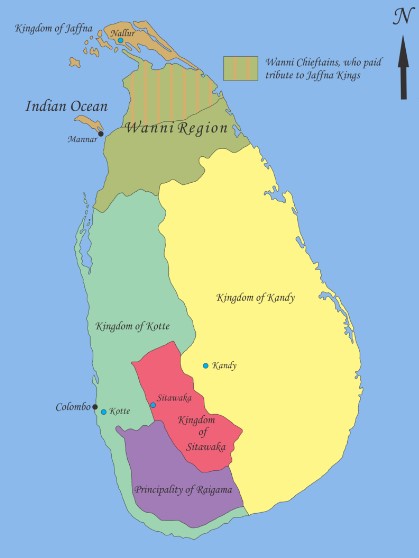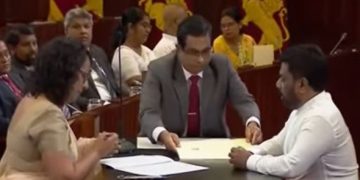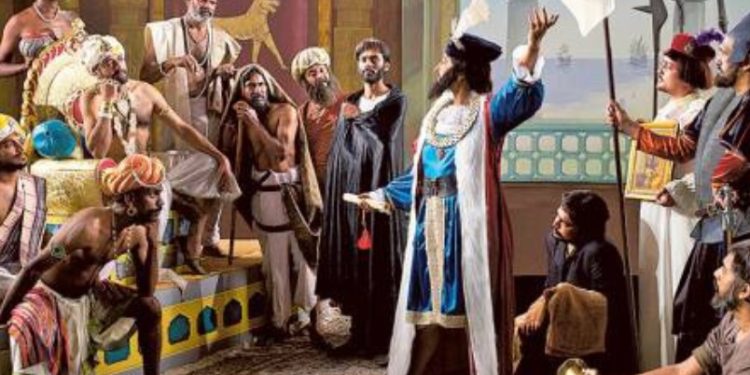By P.K.Balachandran/Sunday Observer
Colombo, October 15: Speaking at the Sitawaka-Sisu Arunalu programme held at the Rajasingha Central College, Hanwella, on September 25, President Ranil Wickremesinghe called for a fresh analysis of the achievements of Rajasingha the First, a “courageous and patriotic” King of Sitawaka, a 16th.century principality in South Central Sri Lanka.
Rajasingha the First or Rajasingha I, ruled Sitawaka from 1581 to 1593. But even before inheriting the throne, when he was Prince Tikiri Bandara, he had become famous because of the crushing defeat he inflicted on the Portuguese in the epic battle of Mulleriyawa in 1559.
Rajasingha was only continuing the anti-Portuguese policy of his father King Mayadunne (1521-1581). Mayadunne carried out a long-drawn battle against the Portuguese with the help of the Zamorin of Calicut in Kerala.
The Zamorin, also known as Samudiri, was a sworn enemy of the Portuguese. Several times, he had sent his navy composed of Moplah Muslims and led by Muslim commanders, to Sri Lanka, to help Mayadunne fight the Portuguese, the common enemy.
Like Mayadunne, the Zamorins were also tormented by the Portuguese who, after landing in Calicut in 1498, demanded iniquitous trading concessions which not only abridged the power of the local ruler but also ate into the businesses of the Moplahs who were a leading trading community in Kerala. Since they were seafarers too, the Moplahs also functioned as the naval arm of the Zamorins.
In the 16th.Century, Sitawaka had acquired a reputation for resolutely opposing the Portuguese who were trying to dominate the Western coastline that was the principal entry point for Europeans.
Vijayabahu VI (1513-1521), was the ruler of Kotte, a coastal principality in which the ports of Colombo and Negombo fell. The Portuguese demanded a monopoly over the purchase of cinnamon from the royal stores at a fixed price. This led to armed clashes between the King and the Portuguese in which Vijayabahu VI was invariably defeated. He was thus forced to accept a grossly unequal trade deal.
In Kotte, the Moplah Muslims from Kerala were an important trading community. The Portuguese’s demand for monopoly over cinnamon trade hurt the Moplahs’ business. But they were staunch allies of the King of Kotte and had very good relations with Sinhalese traders which they used to their advantage.
In 1521, following the death of Vijayabahu VI, Kotte broke into three units with the three sons of the King getting one part each. Mayadunne got Sitawaka; Bhuvanekabahu VII got Kotte on the coast, and Pararajasinghe got Raigam in the South.
Having the ports of Colombo and Negombo in his domain, Bhuvanekabahu VII had to face the brunt of Portuguese ambitions. In 1522, the Moplah traders of Kotte prevailed upon Bhuvanekabahu VII to renege on the deal entered into with the Portuguese by Vijayabahu VI. The Moplahs told the King that the Portuguese were selling Lankan cinnamon in Europe and West Asia at a 300% profit after buying them from the King at a fixed price.
But the weak Bhuvanekabahu VII took a softer line. All he wanted was to keep 40 Bahars (I Bahar=226.8 kg) of cinnamon for the Kingdom’s trade with East Asia. The Portuguese flatly refused to accept any dilution of their monopoly. Bhuvanekabahu VII retaliated by giving the Portuguese poor-quality cinnamon and delaying deliveries.
In 1525, the Moplahs sought military help from the Zamorin of Calicut. A naval force under Ali Hasan was despatched by the Zamorin. Fearing the arrival of Portuguese reinforcements from Goa to attack him, Bhuvanekabahu VII betrayed the Moplahs and attacked Ali Hasan’s fleet in the port.
This shocked the Moplahs and also proved unpopular among the Sinhalese, especially the cinnamon dealers, who had cordial ties with the Moplahs in contrast to antagonistic relations with the Portuguese.
Betrayed by the Kotte Kind and pursued by the Portuguese, the Moplahs fled to Sitawaka, where they were welcomed by Mayadunne. This was applauded by the Sinhalese of Sitawaka for whom Mayadunne was a defender of the Sinhalese against the Portuguese.
But popular support for him boosted Mayadunne’s ambition of taking over Kotte from his elder brother Bhuvanekabahu VI. In 1528 he sought help from the Zamorin of Calicut to drive the Portuguese out of Kotte to deny Bhuvanekabahu VII his main prop. When the Zamorin’s navy comprising Moplahs arrived, Mayadunne declared himself “Chakravathi” in anticipation of conquering Kotte.
On his part, Bhuvanekabahu VII sought the help of the Portuguese in Goa, who sent 10 troop ships. Fearing defeat at the hands of the superior Portuguese, Mayadunne made peace with Bhuvanekabahu VII. With no brief to stay on in Sri Lanka, the Portuguese troops left.
But trouble arose again in 1533 when the Portuguese tried to force a revised trade deal on Bhuvanekabahu VII. They wanted to burn all the poor quality cinnamon given to them by the King so that these did not fall into the hands of the Moplahs. They also demanded that the King agree to a lower selling price.
When the weak King agreed to these terms, the Moplah traders appealed to Mayadunne to attack the Portuguese. To beef up the King’s forces, they got the Zamorin of Calicut to send a force. The Zamorin sent 4000 men under Ali Ibrahim.
To counter this move, Bhuvanekabahu VII sought Portuguese help. But by the time the 11 Portuguese vessels arrived from Cochin in 1537 under Martin Affonso de Souza, Bhuvanekabahu VII and Mayadunne had made up. The Kotte ruler sent back the Portuguese duly compensated.
However, on his volition, the Portuguese commander Martin Affonso de Souza pursued the Moplah fleet up to Mangalore on the Karnataka coast and pulverized it.
Back in Sri Lanka, the peace deal between Mayadunne and Buvanekabahu VII proved to be ephemeral. Mayadunne was itching to fight with Buvanekabahu VII as the latter’s trade deal with the Portuguese continued to irk him and his Moplah Muslim subjects. He again sought military assistance from the Zamorin, who sent 8000 Moplahs in 50 ships under the joint command of Kulhena Marakkar, Payichchi Marakkar and Ali Ibrahim.
En route, the Moplahs attacked Catholic converts on the Kerala coast, an act that infuriated the Portuguese.

As in the past, Bhuvanekabahu VII sent for Portuguese troops from India. 650 Portuguese in 25 ships under Affonso de Souza set sail for Sri Lanka. On February 25, 1538, de Souza defeated the Moplah fleet. But that was in vain because Bhuvanekabahu VII and Mayadunnee had patched up by then.
Before long, Bhuvanekabahu VII was convinced that Mayadunne was eying the Kotte kingdom, having already assumed the title of “Chakravarthi”. To press his claim, Mayadunne sought the Zamorin’s help and to thwart Mayadunne, Bhuvanekabahu VII, sought Portuguese help.
A Portuguese fleet under Miguel Ferreira arrived at Negombo and destroyed the ships of the Calicut navy anchored there. Ferreira’s fleet then came to Colombo and brunt all the Calicut ships there.
In 1539, a Zamorin’s force joined the Sitawaka army when it attacked Kotte. The attack was repulsed by the Portuguese under Miguel Ferreira. But this time, Ferreira wanted the defeat to be meaningful. He demanded that Mayadunne hand over the Moplah generals including the legendary Kulhena Marikkar and Payichchi Marikkar.
Mayadunne said that it would be unethical to hand them over as they had been given refuge. He offered compensation in lieu of surrender. But Ferreira would have none of it. He insisted on having the Marakkars, dead or alive.
Left with no option, Mayadunne beheaded the Marakkars, and sent their heads to Ferreira. This ended the Zamorin’s alliance with Mayadunne and other Sri Lankan Kings.
The Portuguese gained the upper hand in Kotte, especially after the installation on the throne of Dharmapala, Bhuvaneskabahu VII’s grandson who had converted to Catholicism. Feeling highly insecure, Mayadunne agreed to become a vassal of the Portuguese King.
However, Mayadunne’s successor in Sitawaka, Rajasingha I, continued to fight the Portuguese. He dealt a crushing blow to the Portuguese in the battle of Mulleriyawa in 1559. But he could not push the Portuguese out of Sri Lanka.
The reasons were: (1) Absence of naval power to intercept the enemy at sea; (2) Inability to import manpower from India after the Zamorin walked away in 1539; (3) Deficiency in the quality and quantity of firearms.
The Portuguese were superior on all three counts. Additionally, they had the ports of Kotte like Colombo under their control having installed a puppet, Dharmapala, on the throne there.
END
































































